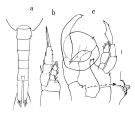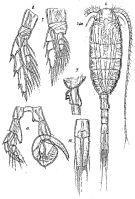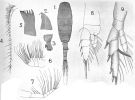|
|
 |
|
Calanoida ( Order ) |
|
|
|
Lucicutiidae ( Family ) |
|
|
|
Lucicutia ( Genus ) |
|
|
| |
Lucicutia pera A. Scott, 1909 (F,M) | |
| | | | | | | Syn.: | Lucicutia lucida : Sars, 1925 (p.219, figs.F,M); Mazza, 1962 (p.339, fig.F); 1967 (p.321, 367); Hure & Scotto di Carlo, 1968 (p.27) | | | | Ref.: | | | A. Scott, 1909 (p.129, Descr.F, figs.F); Sewell, 1948 (p.553); Tanaka, 1963 (p.45, figs.M, Rem.); Hülsemann, 1966 (p.735, figs.F, M); Lapernat, 1999 (p.23, 55, fig.M); Boxshall & Halsey, 2004 (p.132: F; p.134: M); Vives & Shmeleva, 2007 (p.344, figs.F,M, Rem.) |  issued from : O. Tanaka in Publs Seto Mar. Biol. Lab., 1963, XI (1). [p.45, Fig.170]. Male: a, urosome (dorsal); b, P1; c, P5 (blown: 1st basal segment of right leg with a spinous process and haired protuberances)
|
 Issued from : G.O. Sars in Résult. Camp. Scient. Prince Albert I, 69, pls.1-127 (1924). [Pl.LIX, figs.6-11]. As Lucicutia lucida. Female: 6, habitus (dorsal); 7, P1; 8, P5; 9, genital segment (lateral left side); 10, anal segment and caudal rami (dorsal). Nota issued from Hülsemann (1966, p.739): Genital segment asymmetrical (dorsal view). Male: 11, P5. Nota issued from Hülsemann (1966, p.742): Anal segment in length about 2/3 of furca, but still longer than preceding segment. A1 reaching middle of furca.
|
 issued from : A. Scott in Siboga-Expedition, 1909, XIX a. [Plate XL, Figs.1-9]. Female (from Celebes Sea and Banda Sea): 1, habitus (dorsal); 2, forehead (lateral); 3, last thoracic and genital segments (left side); 4, A1; 5, Md (masticatory edge); 6, Mx2; 7, Mxp; 8, P1; 9, P5.
|
 Lucicutia pera Lucicutia pera female: 1 - Characters following not combined : Prosome about 3 times longer than urosome. Cephalosome with slightly projecting and rounded anterior corners and well developed lateral spinous projections; anal somite about as long as wide; caudal rami 11.7 times longer than wide and bowed outwards at base, leaving elliptical space between rami proximally. 2 - P1 with 3-segmented endopod. 3 - Cephalosome without spinous projections . 4 - Genital double-somite asymmetrical (dorsal view).
|
 Lucicutia lpera Lucicutia lpera male: 1 - P1 with 3-segmented endopod. 2 - Cephalosome without lateral projections. 3 - Right A1 reaching at most 2 segments beyond tip of caudal rami. 4 - Caudal rami at most 7 times longer than wide. 5 - Inner margin of basis of right P5 with spiny process. 6 - Anal somite about 67 % as long as caudal rami but longer than preceding somite; A1 reaching tomiddle of anal somite.
| | | | | Compl. Ref.: | | | Roe, 1972 (p.277, tabl.1, tabl.2); Deevey & Brooks, 1977 (p.256, tab.2, Station "S"); Vives, 1982 (p.293); Scotto di Carlo & Ianora, 1983 (p.150); Scotto di Carlo & al., 1984 (1043); Lozano Soldevilla & al., 1988 (p.59); Scotto di Carlo & al., 1991 (p.270); Hure & Krsinic, 1998 (p.102); Lapernat & Razouls, 2001 (p.123, tab.1); Koppelmann & Weikert, 2007 (p.266: tab.3); Mazzocchi & Di Capua, 2010 (p.426); Belmonte, 2018 (p.273, Table I: Italian zones); Hure M. & al. (2018, p.12: Rem.) | | | | NZ: | 5 | | |
|
Distribution map of Lucicutia pera by geographical zones
|
| | | | | |  Chart of 1996 Chart of 1996 | |
| | | | Loc: | | | Canary Is., off Bermuda (Station "S"), Sargasso Sea, Medit. (Alboran Sea, W Basin, Ligurian Sea, Tyrrhenian Sea, off Malta, Adriatic Sea, Ionian Sea, Lebanon Basin), Indonesia-Malaysia (Celebes Sea), Japan (Suruga Bay) | | | | N: | 15 | | | | Lg.: | | | (1) F: 3,6; (5) F: 4; (26) M: 2,85; (199) F: 2,89; (340) M: 3,3; {F: 2,89-4,00; M: 2,85-3,30}
| | | | Rem.: | Bathypelagic. Overall Depth Range in Sargasso Sea: 500-1500 m (Deevey & Brooks, 1977, Station "S");
Presumably confused with Lucicutia lucida by various authors.
After Lapernat & Razouls (2002, p.19) the Itoh's index value = 529 (number of teeth: 11) on the right Md, and 670.7 on the left Md (number of teeth: 10). | | | Last update : 27/10/2020 | |
|
|
 Any use of this site for a publication will be mentioned with the following reference : Any use of this site for a publication will be mentioned with the following reference :
Razouls C., Desreumaux N., Kouwenberg J. and de Bovée F., 2005-2025. - Biodiversity of Marine Planktonic Copepods (morphology, geographical distribution and biological data). Sorbonne University, CNRS. Available at http://copepodes.obs-banyuls.fr/en [Accessed November 30, 2025] © copyright 2005-2025 Sorbonne University, CNRS
|
|
 |
 |






